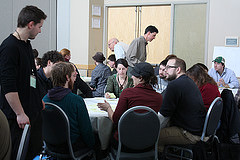
Participants at the Vermont Food Systems Hackathon used concepts from Human Centered Design to develop their ideas.
One of the things that makes our summit unique is that by organizing our sessions into four tracks (Educating for a Digital World, Building Effective Organizations, Creating Resilient Communities, and Steering Vermont’s Digital Future) we want to attract participants from a number of different spheres – from teachers to municipal leaders to visionaries in the fields of technology and innovation – many of whom might not always get a chance to interact and see how their work intersects with each other.
This concept fits right into the idea of Human Centered Design, where a number of different stakeholders all participate to come up with solutions to problems ranging from a way to help children find out where their school bus is in Boston, to a way to make it easier to share knowledge within Philadelphia’s City Hall. The idea is also starting to make inroads in Vermont, where Code for BTV has applied it to their hackathons, and Empatico exposes Vermonters to how the process can facilitate business innovation through its “innovation breakfasts.”
We are, therefore, happy to include a workshop in our agenda called “Human-Centered Design to Improve the Delivery of Government Services,” co-hosted by Amanda Levinson, of Thirdspace, and Erika Lowe, of Today Box Co. Amanda was kind enough to share her thoughts on Human Centered Design, below.
What would it look like for citizens to fully participate in the policy making process and design of public services in the digital age?
In an era where the attention and participation of citizens is increasingly fragmented, governments need new technologies and new strategies for increasing public participation to make people feel like they have a stake in the outcomes. We also need spaces where people, experts and government work together together to provide better public services.
Some governments are turning to human centered design, or design thinking, to increase public participation and come up with bolder ideas for the delivery of public services.
Human centered design is an active and participatory process that uses the understanding of people’s experiences to design services and products. It’s been used everywhere – from the private sector to higher ed to the public sector to the developing world – in order to create new solutions to design challenges.
In the public sector, the idea is that if citizens are put in the center of the service design process, whether for a new technology or other government service, they will become become agents of change, and the services will be more responsive to their needs as well.
The UK government is taking the lead in integrating human centered design into the design and delivery of public services, having established a lab specifically for the purpose of getting more citizens engaged. Here in the states, the mayors of Boston and Philadelphia are integrating human-centered design into their pioneering Departments of New Urban Mechanics, which take online and offline approaches to collaborating with constituents to focus on bolder ideas + better services.
Can this work in Vermont? Vermont has a robust tradition of civic participation through the town hall meeting, and Front Porch Forum is certainly a vibrant platform for digital engagement. At the same time, all of our citizens need more opportunities, avenues and platforms to have a voice in the service design and policymaking process. By starting with citizens as key stakeholders and trying to build things from their needs, we’ll have a more engaged citizenry – and hopefully better outcomes for everybody.
Since the best way to understand human-centered design is to go through the process, my colleague Erika Lowe and I will be doing a mini design challenge during the conference so people can see how it can be used to generate new ideas to solve problems in their communities.
